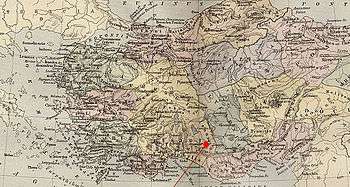Isaura Palaea
Isaura Palaea (Ancient Greek: Ἴσαυρα Παλαιά, romanized: Isaura Palaia), in Latin Isaura Vetus, both meaning 'Old Isaura', and perhaps identical to Isauropolis,[1] was a Roman and Byzantine era town in southern Turkey.[2] The city has been identified with modern Zengibar Kalesi near Konya.[3]

In antiquity the city was in Isauria (Ἰσαυρία) district[4] of Lycaonia in today's southern Turkey (modern Konya Province). Its site is identified as near Bozkır.[1][5]
History
_p469_PLAN_OF_THE_RUINES_OF_THE_CITY_OF_ISAURA.jpg)
Before the Romans the town was a strongly fortified city of the Isaurians, located at the foot of Mt. Taurus. It was besieged by Perdiccas, the Macedonian regent after Alexander the Great's death, the Isaurians set the place alight and let it perish in flames rather than submit to capture.[6] Large quantities of molten gold were found afterwards by the Macedonians among the ashes and ruins.[7] The town was rebuilt, but was destroyed a second time by the Roman, Servilius Isauricus (c. 75 BCE), and thenceforth it remained a heap of ruins. Strabo states that the place was ceded by the Romans to Amyntas of Galatia.[8] It was rebuilt by Amyntas at a new location and called Isaura Nea ('New Isaura').
From 492-496 the area was fought over between emperor Anastasius I and the local rebels, in what was to become known as the Isaurian War.
The Seljuq Turks manage to take control of the area in the late 11th century, after the Battle of Manzikert.
References
- Lund University. Digital Atlas of the Roman Empire.
- Rogers, Clifford (June 2010). The Oxford Encyclopedia of Medieval Warfare and Military Technology, Volume 1 . Oxford University Press. p. 42.
- Tomaschitz, Kurt, "Isauria, Isauri", Brill’s New Pauly, doi:10.1163/1574-9347_bnp_e527580
- W. M. Ramsay, The Historical Geography of Asia Minor (2010) p395].
- Richard Talbert, ed. (2000). Barrington Atlas of the Greek and Roman World. Princeton University Press. p. 66, and directory notes accompanying.
- Rogers, Clifford (June 2010). The Oxford Encyclopedia of Medieval Warfare and Military Technology, Volume 1. Oxford University Press. p. 42. ISBN 978-0-1953-3403-6.
- Diodorus Siculus. Bibliotheca historica (Historical Library). 18.22.
- Strabo. Geographica. xii. p. 568. Page numbers refer to those of Isaac Casaubon's edition.
![]()